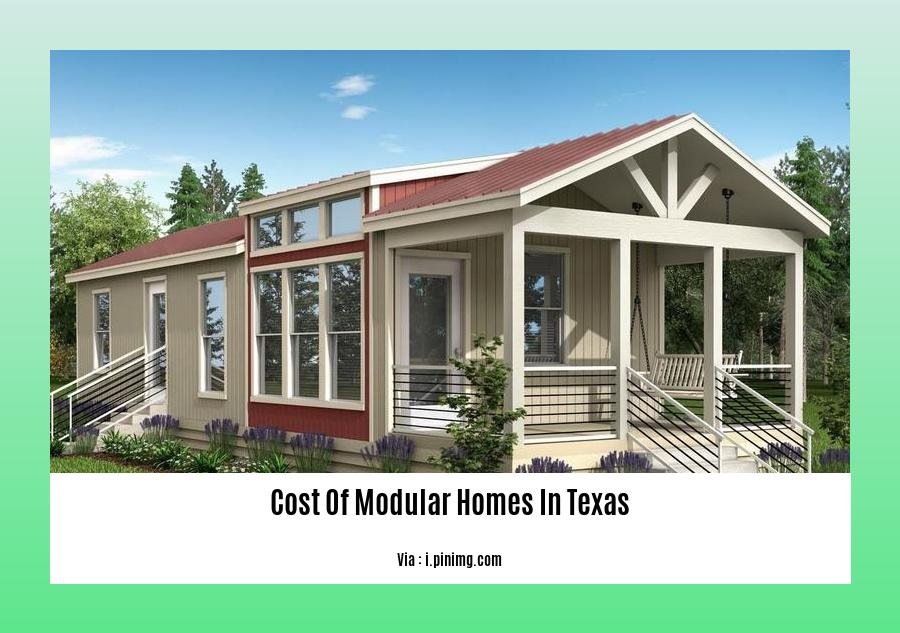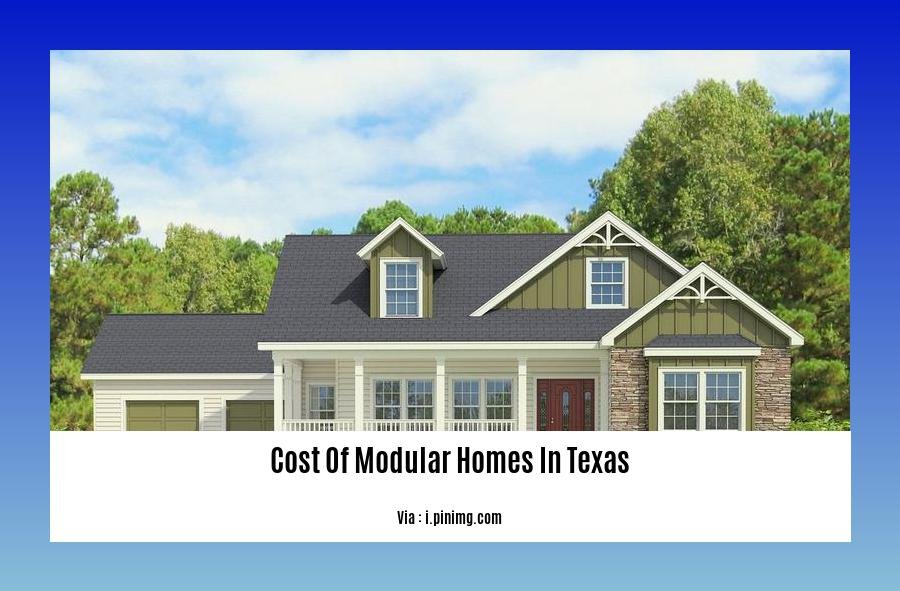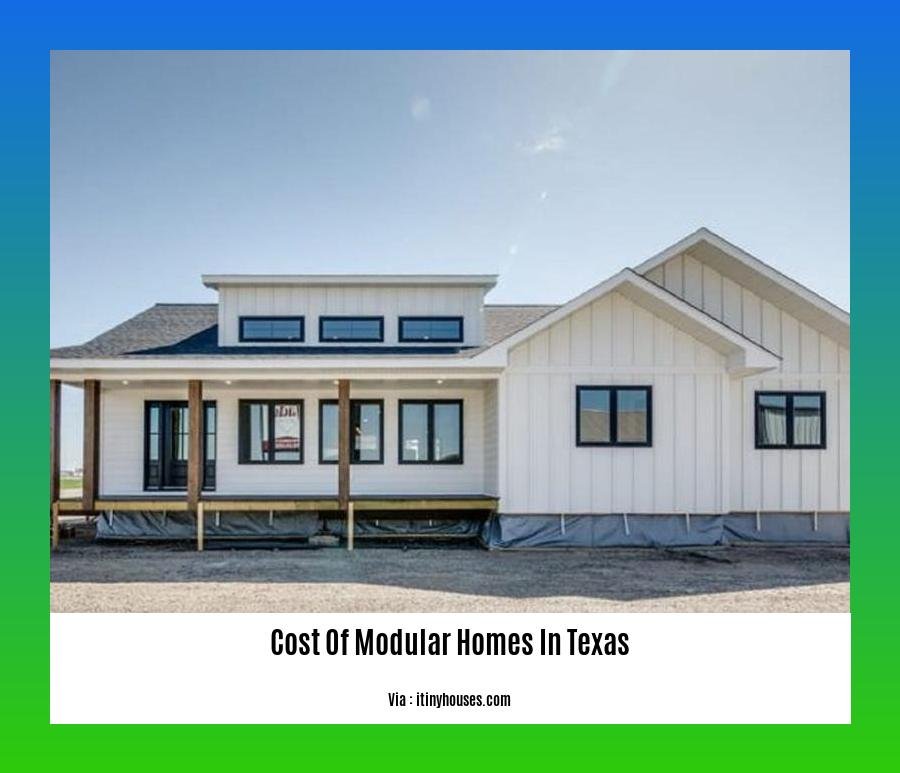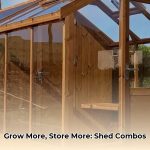Unveiling the Cost of Modular Homes in Texas: A Comprehensive Analysis. Texan homebuyers, are you ready to delve into the world of modular homes? Discover the intricate details of modular home pricing, construction costs, and financing options in the Lone Star State. Our comprehensive guide explores the advantages and potential savings of modular construction, providing you with the knowledge to make informed decisions about your future home.
Key Takeaways:
-
In Texas, modular homes offer a significant cost advantage over traditional site-built homes.
-
The average cost of a site-built home in Texas is $260,000, while modular homes typically range from $55 to $75 per square foot, resulting in a total cost of approximately $117,000.
-
Texas has a well-established modular home industry, with 81 modular communities, 2,034 available homes from 75 builders, and a wide price range of $33,900 to $8,889,701.
-
Modular construction is a versatile building method that can create various housing types, including ranch homes, man camps, single-family homes, townhouses, apartments, and multi-family units.
-
Modular homes can provide affordable and sustainable housing solutions to address the growing demand for housing in Texas.
Cost of Modular Homes in Texas

Modular homes are gaining popularity in Texas due to their affordability, sustainability, and quick construction time.
Factors Affecting the Cost of Modular Homes in Texas:
- Type of Modular Home:
- Single-family homes: $55-$75 per square foot
- Multi-family units: $60-$80 per square foot
-
Commercial buildings: $80-$100 per square foot
-
Size and Design:
- Larger homes with intricate designs cost more.
-
Simple designs and smaller homes are more budget-friendly.
-
Location:
- Urban areas tend to have higher costs due to land prices and labor expenses.
-
Rural areas generally have lower costs associated with land and labor.
-
Transportation and Installation:
- The cost of transporting modular units to the construction site varies depending on distance.
-
Installation costs can vary depending on the complexity of the project and local labor rates.
-
Site Preparation:
-
Preparing the land for the modular home, including excavation, leveling, and utility connections, impacts the overall cost.
-
Permits and Fees:
-
Building permits, inspections, and other fees associated with modular home construction can vary by location.
-
Interior Finishes and Upgrades:
- Customizations such as premium appliances, flooring, countertops, and fixtures can increase the total cost.
Advantages and Disadvantages of Modular Homes:
Advantages
– Faster construction time
– Cost-effective compared to traditional site-built homes
– Energy-efficient and sustainable
– Customizable to meet specific needs
Disadvantages
– Limited availability of designs and styles
– Potential for lower resale value compared to site-built homes
– Site preparation and foundation requirements
Conclusion:
The cost of modular homes in Texas varies depending on various factors such as type, size, location, transportation, installation, site preparation, permits, and interior finishes. Modular homes offer advantages like affordability, sustainability, and quick construction, but they also have potential drawbacks. Carefully considering these factors and consulting with modular home builders can help individuals make informed decisions about whether a modular home aligns with their needs and budget.
Looking to build an affordable, energy-efficient home in Michigan? Explore the cost of modular homes in Michigan and discover the benefits of modular construction.
Considering a modular home in North Carolina? Get the latest information on cost of modular homes in NC and learn why modular homes are becoming increasingly popular in the state.
Building a modular home in the UK? Find out the cost of modular homes in the UK and see how modular construction can help you save time and money while getting the home of your dreams.
Cost Breakdown: Materials, Labor, Permits, Foundation, Utilities, Landscaping
When thinking about building a modular home in Texas, understanding the cost involved is essential. So, let’s dive into the details!
Materials:
These are the building blocks of your home and can account for a significant portion of the total cost. Expect to shell out anywhere from $30,000 to $100,000 for materials depending on the size and design of your dream home.
Labor:
Skilled workers bring your modular home to life, and their expertise doesn’t come cheap. Labor costs can range from $5,000 to $15,000, depending on the complexity of your project.
Permits:
Before you start building, you’ll need to obtain the necessary permits from local authorities. These fees vary depending on your location but typically fall between $500 and $2,000.
Foundation:
A solid foundation is crucial for the longevity of your home. Depending on your soil conditions and the size of your home, foundation costs can range from $5,000 to $20,000.
Utilities:
Connecting your modular home to essential services like electricity, water, and sewage is a must. These costs can vary significantly based on your location and the availability of utilities. Be prepared to spend anywhere from $5,000 to $15,000 on these connections.
Landscaping:
Curb appeal is everything! Landscaping can enhance the aesthetics of your modular home and make it blend seamlessly with the surroundings. Depending on your desired level of landscaping, expect to spend around $5,000 to $10,000.
Key Takeaways:
- Modular homes can be affordable housing options, but costs can vary based on size, design, location, and materials.
- Material costs can range from $30,000 to $100,000.
- Labor costs can range from $5,000 to $15,000.
- Permit fees typically fall between $500 and $2,000.
- Foundation costs can range from $5,000 to $20,000.
- Utility connections can range from $5,000 to $15,000.
- Landscaping costs can range from $5,000 to $10,000.
Citations:
[
[
Maintenance and repair costs: routine maintenance, repairs, warranties.

To make an informed decision about purchasing a modular home, it’s essential to consider the associated costs beyond the initial purchase price. Maintenance and repair costs: routine maintenance, repairs, warranties. can vary depending on several factors. Understanding these costs can help ensure you’re adequately prepared for the financial commitment of owning a modular home.
Key Takeaways:
-
Routine Maintenance: Regular maintenance is crucial to keep your modular home in good condition and prevent costly repairs. Plan for annual check-ups and maintenance tasks like cleaning gutters, replacing air filters, and checking for leaks. These measures can help identify potential issues early on and prevent them from escalating into significant problems.
-
Repairs: Despite regular maintenance, unforeseen repairs may arise. These costs can vary widely depending on the type of repair, materials needed, and labor charges. Having an emergency fund or a home warranty can help cover unexpected repair expenses.
-
Warranties: Many modular home manufacturers offer warranties to protect buyers against defects in materials or workmanship. The warranty period and coverage can vary, so it’s important to carefully review the warranty terms before making a purchase. Understanding the warranty details can provide peace of mind and potentially save you money on repairs during the warranty period.
Planning for Maintenance and Repair Costs:
-
Budgeting for Routine Maintenance: Aim to allocate around 1% to 3% of your home’s purchase price annually for routine maintenance expenses. This can help ensure you have the necessary funds to cover regular maintenance tasks and minor repairs.
-
Preparing an Emergency Fund: Set aside an emergency fund specifically for unexpected home repairs. This fund can provide a financial cushion to cover sudden expenses without straining your budget.
-
Considering a Home Warranty: Research and compare different home warranty plans available in your area. A home warranty can offer coverage for major appliances, plumbing, electrical systems, and other components, potentially saving you money on repairs during the warranty period.
By considering maintenance and repair costs: routine maintenance, repairs, warranties. when planning for a modular home purchase, you can make informed decisions about your financial commitment and ensure you’re adequately prepared for the long-term ownership of your home.
Citations:
– The Balance: How Much Does Home Maintenance Cost?
– HomeAdvisor: How Much Does a Home Warranty Cost?
Budgeting and financing options: upfront costs, long-term savings, available financing options.
Modular homes offer an affordable and sustainable housing option in Texas, but their upfront costs can be a hurdle for some homebuyers. To make modular homes more accessible, various financing options are available. These options offer flexible terms, competitive interest rates, and long-term savings, making it easier to own a modular home in Texas. Let’s explore these budgeting and financing options in detail:
Key Takeaways:
- Upfront Costs: The upfront costs of a modular home vary depending on size, features, and location. They include:
- Land Acquisition: Acquiring a suitable lot for your modular home.
- Site Preparation: Preparing the land for the installation of the modular home.
- Modular Home Purchase: The cost of the modular home itself, including any upgrades or customizations.
- Permits and Fees: Fees associated with building permits and inspections.
-
Transportation and Installation: Costs for transporting and installing the modular home.
-
Long-Term Savings: Modular homes offer long-term savings in several ways:
- Energy Efficiency: Modular homes are often built with energy-efficient materials and appliances, leading to lower utility bills.
- Lower Maintenance Costs: Modular homes are designed to be low-maintenance, requiring minimal repairs and maintenance compared to traditional homes.
-
Appreciation:* Modular homes, like traditional homes, have the potential to appreciate in value over time, providing a potential return on investment.
-
Available Financing Options: Here are the various financing options available for modular homes in Texas:
- Conventional Mortgages:* These mortgages, offered by banks and credit unions, require a down payment and have fixed interest rates for the loan term.
- FHA Loans:* FHA loans, insured by the Federal Housing Administration, offer flexible credit requirements and low down payment options.
- VA Loans:* VA loans are available to eligible veterans and active-duty military members, offering competitive rates and no down payment requirement.
- USDA Loans:* USDA loans are designed for rural homebuyers, providing low interest rates and no down payment requirement.
- Modular Home Loans:* Specialized modular home loans are offered by lenders, with terms tailored specifically for modular home purchases.
In addition to financing options, there are various budgeting strategies that can help you plan for the upfront costs of a modular home in Texas:
- Establish a Savings Plan: Start saving early to accumulate a down payment and cover any upfront costs.
- Explore Down Payment Assistance Programs: Down payment assistance programs can provide grants or low-interest loans to help you cover the down payment.
- Consider a Modular Home Lease-to-Own Option: Some manufacturers offer lease-to-own programs, allowing you to rent a modular home with the option to purchase it in the future.
By carefully considering available financing options and budgeting strategies, you can overcome the upfront costs associated with modular homes in Texas and make your dream of homeownership a reality.
Relevant URL Sources:
- Modular Home Financing Options in Texas
- Guide to Budgeting for a Modular Home in Texas
FAQ
Q1: What is the typical price range for modular homes in Texas?
A1: Modular homes in Texas typically cost between $55 to $75 per square foot, amounting to an average total cost of around $117,000.
Q2: Are modular homes more expensive than traditional site-built homes in Texas?
A2: No, modular homes in Texas are generally more cost-effective compared to traditional site-built homes. The average cost of a site-built home in Texas is $260,000, making modular homes a more affordable option.
Q3: Does the cost of modular homes vary depending on the size and complexity of the design?
A3: Yes, the cost of modular homes can vary based on the size and complexity of the design. Larger homes and those with intricate designs tend to have higher costs.
Q4: How do I estimate the total cost of a modular home in Texas?
A4: To estimate the total cost of a modular home in Texas, multiply the cost per square foot ($55 to $75) by the desired square footage of your home. Additionally, factor in the site preparation, design and engineering, home construction, and exterior finishes costs. Sales tax may also apply, ranging from 4-5% of the total cost.
Q5: What are the advantages of choosing a modular home over a traditional site-built home?
A5: Modular homes offer various advantages, including cost-effectiveness, faster construction time, energy efficiency, and more sustainable building practices. Additionally, modular homes can be customized to suit specific needs and preferences.
- Greenhouse Storage Shed Combos: Your Guide to Combining Growing and Storage - April 21, 2025
- Greenhouse Shed Combo: Design, Build & Grow Year-Round - April 21, 2025
- Gingham vs. Plaid: What’s the Difference? A Complete Guide - April 21, 2025










